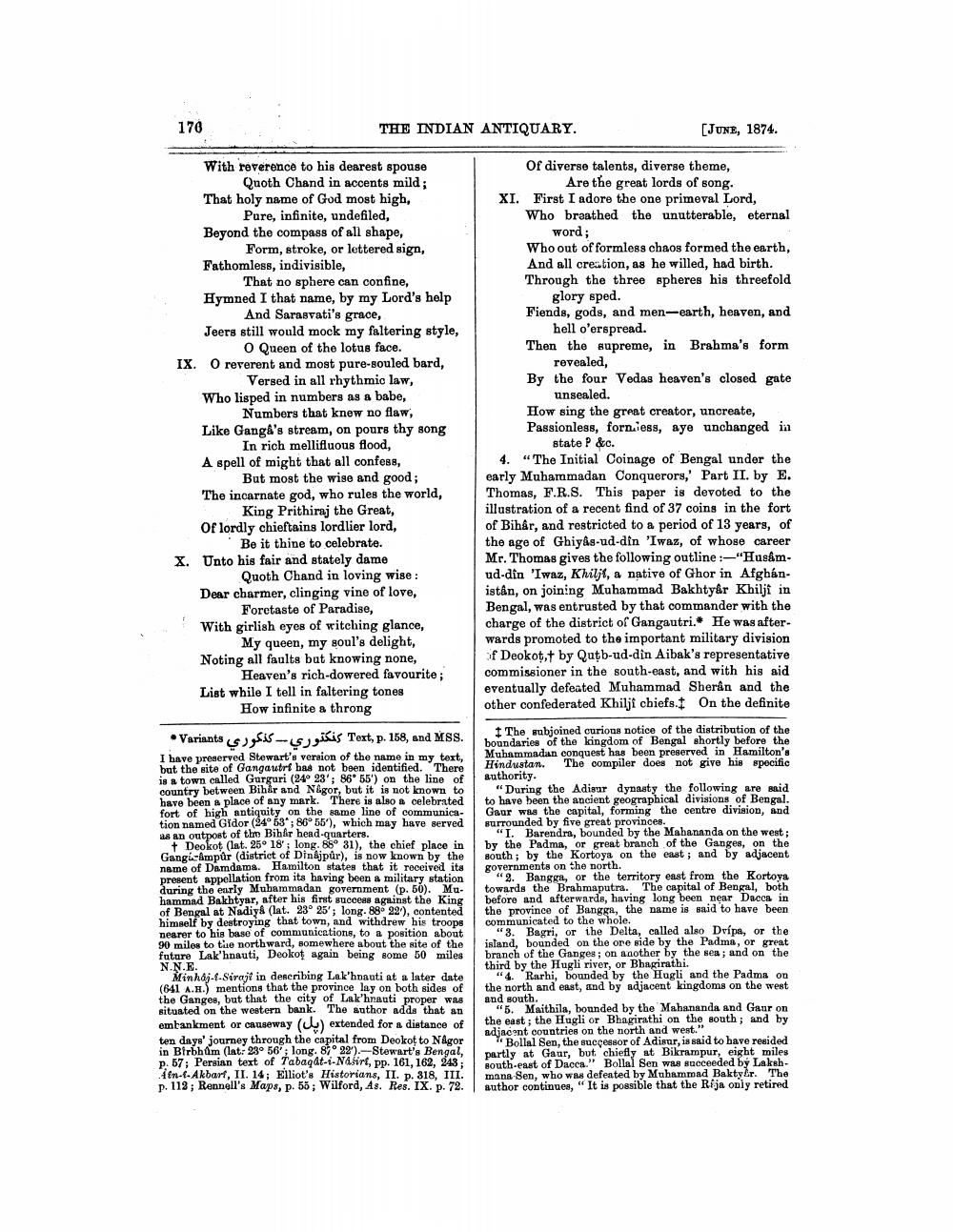________________
170
THE INDIAN ANTIQUARY.
[JUNE, 1874.
With reverence to his dearest spouse
Quoth Chand in accents mild; That holy name of God most high,
Pure, infinite, undefiled, Beyond the compass of all shape,
Form, stroke, or lettered sign, Fathomless, indivisible,
That no sphere can confine, Hymned I that name, by my Lord's help
And Sarasvati's grace, Jeers still would mock my faltering style,
O Queen of the lotus face. IX. O reverent and most pure-souled bard,
Versed in all rhythmic law, Who lisped in numbers as a babe,
Numbers that knew no flaw, Like Ganga's stream, on pours thy song
In rich mellifluous flood, A spell of might that all confess,
But most the wise and good; The incarnate god, who rules the world,
King Prithiraj the Great, Of lordly chieftains lordlier lord,
Be it thine to celebrate. X. Unto his fair and stately dame
Quoth Chand in loving wise : Dear charmer, clinging vine of love,
Foretaste of Paradise, With girlish eyes of witching glance,
My queen, my soul's delight, Noting all faults but knowing none,
Heaven's rich-dowered favourite; List while I tell in faltering tones
How infinite a throng
Of diverse talents, diverse theme,
Are the great lords of song. XI. First I adore the one primeval Lord, Who breathed the unutterable, eternal
word; Who out of formless chaos formed the earth, And all creation, as he willed, had birth. Through the three spheres his threefold
glory sped. Fiends, gods, and men-earth, heaven, and
hell o'erspread. Then the supreme, in Brahma's form
revealed, By the four Vedas heaven's closed gate
unsealed. How sing the great creator, uncreate, Passionless, forniess, aye unchanged in
state ? &c. 4. "The Initial Coinage of Bengal under the early Muhammadan Conquerors,' Part II. by E. Thomas, F.R.S. This paper is devoted to the illustration of a recent find of 37 coins in the fort of Bihar, and restricted to a period of 13 years, of the age of Ghiyâs-ud-din 'Iwaz, of whose career Mr. Thomas gives the following outline:-"Husmud-din 'Iwaz, Khilji, a native of Ghor in Afghán. istân, on joining Muhammad Bakhtyar Khilji in Bengal, was entrusted by that commander with the charge of the district of Gangautri. He was afterwards promoted to the important military division Of Deokot,t by Qutb-ud-din Aibak's representative commissioner in the south-east, and with his aid eventually defeated Muhammad Sheran and the other confederated Khilji chiefs. On the definite
by the pathe Korto the
east from the
tohoth
• Variants vs) Sisus misis Text, p. 158, and MSS. I have preserved Stewart's version of the name in my text, but the site of Gangautrf has not been identified. There is a town called Gurguri (24° 23'; 86° 55') on the line of country between Bihir and Nigor, but it is not known to have been a place of any mark. There is also celebrated fort of high antiquity on the same line of communication named Gidor (24° 53'; 86° 55'), which may have served as an outpost of thm Bihfr head-quarters.
+ Deokot (lat. 25° 18'; long. 88° 31), the chief place in Gangé-impûr (district of Dinajpur), is now known by the name of Damdama. Hamilton states that it received its present appellation from its having been a military station during the early Muhammadan government (p. 50). Muhammad Bakhtyar, after his first success against the King of Bengal at Nadiya (lat. 23° 25'; long. 88. 22), contented himself by destroying that town, and withdrew his troops nearer to his base of communications, to a position about 90 miles to tue northward, somewhere about the site of the future Lakhnauti, Deokot again being some 50 miles N.N.E.
Minhaj-f-Siraji in describing Lak'hnauti at a later date (641 A..) mentions that the province lay on both sides of the Ganges, but that the city of Lakhnauti proper was situated on the western bank. The author adds that an embankment or causeway ( ) extended for a distance of ten days' journey through the capital from Deokot to Nagor in Birbhum (lat: 23° 56'; long. 87°22').-Stewart's Bengal, p. 57; Persian text of Tabaqdt-i-Nazirt, pp. 161, 162, 243; i en-l-Akbari, II. 14; Elliot's Historians, II. p. 318, III. p. 112; Rennell's Maps, p. 56; Wilford, As. Res. IX. p. 72.
The subjoined curious notice of the distribution of the boundaries of the kingdom of Bengal shortly before the Muhammadan conquest has been preserved in Hamilton's Hindustan. The compiler does not give his specific authority.
"During the Adisur dynasty the following are said to have been the ancient geographical divisions of Bengal. Gaur was the capital, forming the centre division, and surrounded by five great provinces.
"I. Barendra, bounded by the Mahananda on the west; by the Padma, or great branch of the Ganges, on the south; by the Kortoya on the east; and by adjacent governments on the north.
"2. Bangga, or the territory east from the Kortoya towards the Brahmaputra. The capital of Bengal, both before and afterwards, having long been near Dacca in the province of Bangga, the name is said to have been communicated to the whole.
"3. Bagri, or the Delta, called also Dvípa, or the island, bounded on the ore side by the Padma, or great branch of the Ganges; on another by the sea, and on the third by the Hugli river, or Bhagirathi.
"4. Rarhi, bounded by the Hugli and the Padma on the north and east, and by adjacent kingdoms on the west and south.
"5. Maithila, bounded by the Mahananda and Gaur on the east, the Hugli or Bhagirathi on the south; and by adjacent countries on the north and west."
Bollal Sen, the successor of Adisur, is said to have resided partly at Gaur, but chiefly at Bikrampur, eight miles south-east of Dacca." Bollal Sen was succeeded by Lakshmana Sen, who was defeated by Muhammad BaktyZr. The author continues, "It is possible that the Rēja only retired




